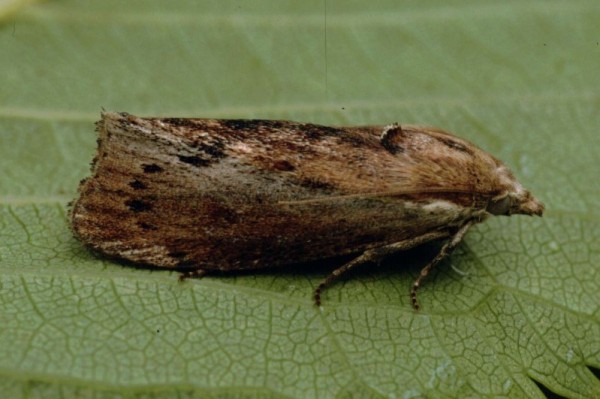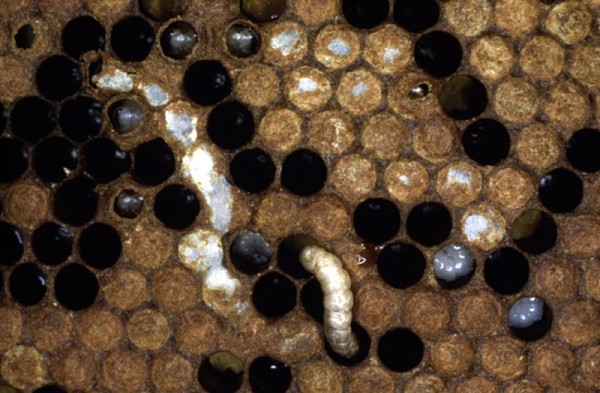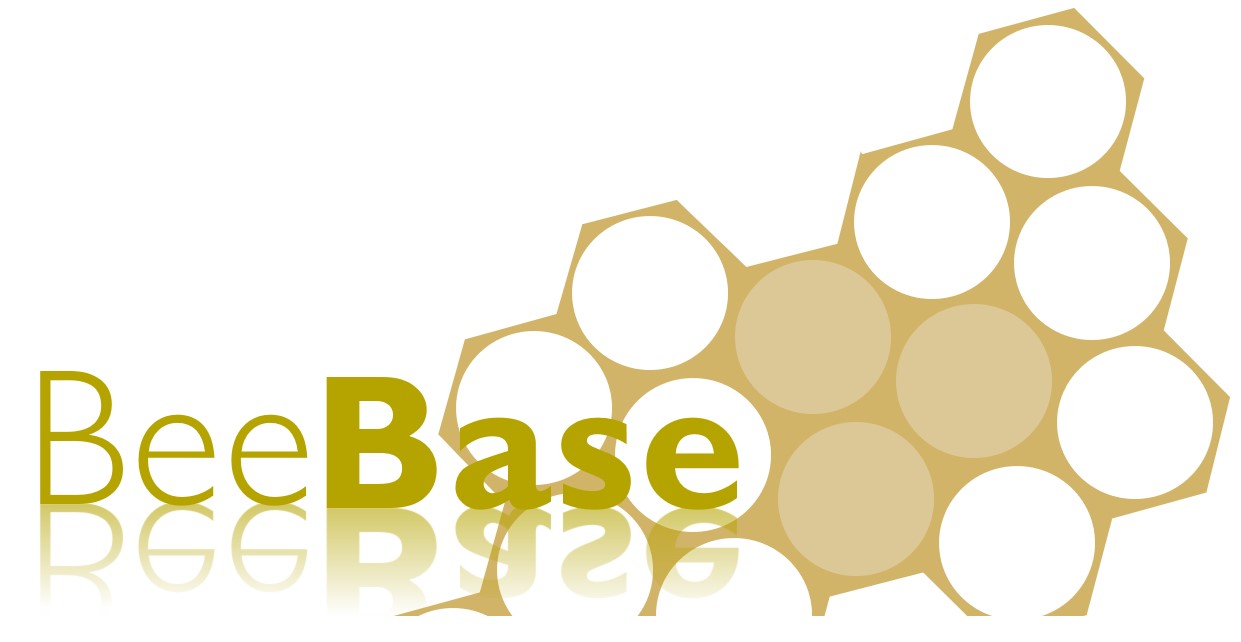There are currently two known species of wax moth that occupy and damage honey bee colonies. Each one has four stages of development: egg; larva; pupa; and adult. The greater wax moth, Galleria mellonella is the more destructive and common pest whilst the lesser wax moth, Achroia grisella is both less prevalent and less destructive. Wax moth infestations are caused by unhygienic management practices; leaving scraps of burr comb lying around the apiary and empty and exposed supers or brood boxes with drawn comb in will attract moths. When the equipment is left over a long period of time, this gives ample opportunity for infestations of wax moth to get out of control. Drawn comb can become damaged and eaten away, making in unworkable for colonies of honey bees.
Although considered a minor pest, wax moths can cause damage to beekeeping equipment and to stored comb. They are a particular problem for colonies that are weak or diseased. Beekeepers are encouraged to keep strong and prolific colonies, which are better able to defend against infestations.
 Wax moth cocoons (hatched)
Wax moth cocoons (hatched)
Biology
Females oviposit eggs into crevasses and gaps within the hive where they remain out of reach of nursing bees. Once the larvae hatch, they immediately search for comb in which to feed. The thoracic legs are immediately visible and well developed and as the larva feeds and grows they develop, the abdominal legs become more prominent after around 3 days old. Speed of growth is directly dependent on temperature and food supply. Under ideal conditions the larval weight can double daily during the first 10 days.
A greater wax moth larva moults 7 times throughout its development. Most of the growth and size increase happens during the final 2 instars. Larval development lasts 6-7 weeks at 29° - 32° C and high humidity. As the greater wax moth larva matures, it will reach a length of around 20 mm and its body will turn grey in colour with a brown prothoracic shield having a broad band across it.
Mature greater wax moth larvae bore into wood and often make boat-shaped indentations in the hive body or frames. After finding a place in the hive to pupate, the larva begins spinning a silk thread cocoon, which they attach to the excavated indentations. The development stage of greater wax moths varies from 6 to 55 days, depending on factors such as temperature.
Adult moths reach a length of 15 mm long with a 31 mm average wingspan. The wings are grey in colour but the hind third of the wing, normally hidden, is bronze coloured.
 Galleria mellonella, the Greater Wax Moth
Galleria mellonella, the Greater Wax Moth
Damage to colonies
The larvae of both species cause damage to comb by feeding on the wax, though they cannot survive on wax alone; larvae fed on pure bees wax have been shown to stop developing. They rely on other impurities within the wax - particularly cocoons in old brood combs. One obvious sign of a wax moth infestation is a white silk trail left by burrowing larvae moving below the cappings of honey bee brood. In extreme cases the whole of the comb will be destroyed, leaving a matted mass of silk, frass and other debris.
Mature greater wax moth larvae bore into woodwork and often make boat-shaped indentations in brood boxes, supers, crownboards and frames. After finding a place to pupate, the larva begins spinning silk threads to make the cocoon, which can be seen attached to the excavated indentations. On close inspection, one will find large amounts of cocoons congregated in areas around the periphery of the bee nest.
Wax moth is known for causing Bald Brood a common disorder in the colony. Further details can be found on our Other Brood Disorders page.  Wax moth larva tunnelling across cappings of sealed brood
Wax moth larva tunnelling across cappings of sealed brood
Control
Good strong colonies will not usually tolerate infestation by wax moth, and it is not usually a problem in the field in healthy colonies. However, it is a problem in either weak colonies or hives where colonies have died or in stored combs. In the field hives should be kept as strong and healthy as possible, combs should not be left lying around the apiary and dead colonies should be removed as this will attract wax moths (basic apiary hygiene!). Lightly infested boxes may be placed on strong colonies to clean out, but heavily infested combs cannot be effectively treated and should be burned.
Are there other species of wax moth?
The moth, Aphomia sociella is known as the “bee moth” and is very similar to the greater wax moth. The body and forewings are a reddish brown and the forewing of the female moth, has a distinct dark spot on it. This sub-species is attracted by the scent of bumble bee and wasp species nests, feeding on the waste products of the larvae, as well as dead adults. Larvae reach 24–30 mm in length and become distinctly yellow in colour. They create tunnels of silken thread throughout the nest and as a result, bumble bees may abscond their nest during high infestations.
Further reading
- Further information about the biology and identification features of all stages of wax moth can be found on the COLOSS website.
- The NBU's Wax moth Factsheet (a'r fersiwm Cymraeg yma)
